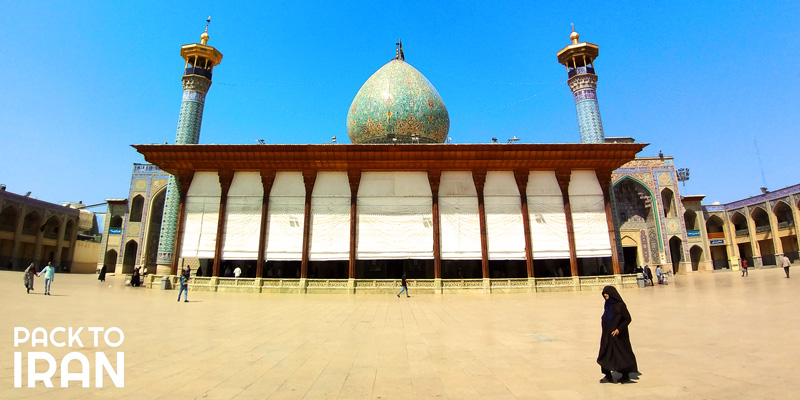After the entrance of Islam to Iran, different kings and governors who ruled Iran throughout the Islamic era, managed to build glorious mosques that are today from the most important elements of the history of architecture in Iran. Almost every historical city of Iran has some historical mosques, and the wonderful city of Shiraz in not an exception. One of the oldest and most important attractions of Shiraz is the decent Atiq Mosque.
The History of Jame Atiq Mosque of Shiraz
The archaeological excavations show that the Jame Atiq Mosque of Shiraz might be constructed on the remains of an ancient temple probably a Zoroastrian fire temple, and the plan of the previous temple had an impact on the design of the current mosque. The historians do not know the exact age of the fire temple, however what can be taken for granted is that it had been built during the pre-Islamic era. Other documents that proof the antiquity of the Jame Atiq Mosque of Shiraz are the travel books that have mentioned this construction. Mughadasi, the great traveler of Islamic world has written that this mosque is so stunning that it is one of a kind in all seven lands, and Ibn Battuta describes it as one of the greatest and most wonderful mosques of the Islamic world.
The current mosque was built during the kingdom of Amir ibn al-Layth, the second ruler of the Saffarid Dynasty in Iran (879 to 901). This mosque has been renovated and amended for many times during its history. The first amendment was done during the reign of the Atabegs of Fars (Salghurids) during the 13th century, and then by the order of Sultan Ibrahim Mirza, the governor of Fars Province and the son of Shahrukh the king of Teimurid Dynasty. Later, during the Safavid era (16th – 17th centuries), which is known az the zenith of art and architecture in Iran, the Jame Atiq Mosque was amended and renovated again, and then in 1937 this mosque was renovated again by a budget supplied by the Archaeology organization and the people of Shiraz.
Jame Atiq Mosque of Shiraz
The Architecture of Jame Atiq Mosque of Shiraz
The construction of the Jame Atiq Mosque of Shiraz has amazing architectural characteristics on each side, that have caused it to be an amazing place for the architecture and art lovers.
The North side
This side of the mosque is faced to the Qibla and has two entrance doors, an iwan (a vaulted hall), and a shabistan. One of the entrance doors are named the 12 Imam door because of its muqarnas tile works and inscription showing the name of all 12 Shiite imams. There is also another inscription which mentions the date of amendment during the Safavid era. There is also a high vault named the pearl vault which has muqarnas brickworks on the ceiling and two minarets.
The West Side
The door connecting the Jame Atiq Mosque and the Shah Cheragh Holy Shrine is located on this side, and also has beautiful porticos (Ravaq) which are roofed corridors with vaults. At the end of the Ravaq there are entrance doors to Shabistans of the southern side.
The Southern Side (back to the Qibla)
This side is characterized by its high façade, which got amended about 70 years ago, and a shabistan (hall) which was built in two floors with brick ceiling and a stunning mihrab. This mihrab is ornamented with muqarnas turquoise tilework and two stone-made columns.
The East side (Back to the sunlight)
This side has a façade similar to the southern one with four arcs on each side. The stairway to the roof of the mosque is located on this side. There is a ruined shabistan on this side which is locked and is not used anymore. This shabistan was used as a cultural center until 40 years ago.
Tari khaneh
The most amazing and famous element of the Jame Atiq Mosque of Shiraz is the Tari Khane, also known as Dar ol Mashaf and Khoday Khaneh, which literally means the house of God. This construction was built at the center of the courtyard of the mosque by the order of Shah Ishaq Inju the most famous governor of the Inju Dynasty who ruled over Isfahan and Fars provinces. This was a place where they wrote and kept the holy Quran book. Religious men used to gather at this building for reading Quran. A historical and hand written Quran related to the Safavid era, which was kept at this building is today kept at the Pars Museum of Shiraz.
The Tari Khaneh is a rectangular construction with round columns and iwans on the four sides with rooms which are reachable from the northern and southern sides. The inscription of this construction is a masterpiece of calligraphy with Persian and Arabic poems about Quran. The interesting thing about this place is that according to a history book about Shiraz, the Tari Khaneh was the place where Hafez the great Persian poet used to go every Friday night for reading Quran.
Visiting the Jame Atiq Mosque of Shiraz
After visiting the Shah Cheragh Holy Shrine you can pass the eastern entrance and reach the Jame Atiq Mosque. This mosque is available for public visit and no entrance fee is required.








